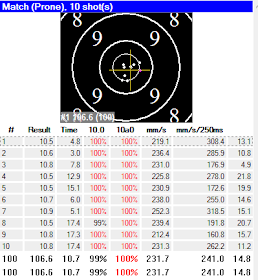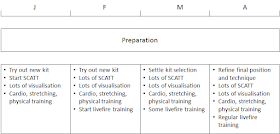One of the questions which comes up occasionally on internet boards and which can cause a bit of consternation is whether greater allowance should be made for wind conditions nearer the shooter or nearer the target. A surprising number of people believe that the wind nearer the target will have a greater effect, after all the bullet is going much more slowly when it gets to the other end.
Let's look the ballistics of a shot fired by a target rifle shooter on a flat, open range with a 10 mile per hour crosswind from 3 o'clock. (S)he is using ammunition with an old-style Sierra 155 HPBT bullet
(part number 2155) with an average real-world BC of 0.417 (vid.
Brian Litz's superb experimental data) which achieves a muzzle velocity of
2925fps*. Using the
JBM Ballistics page, we get the following results:
| Range |
Muzzle |
100x |
200x |
300x |
400x |
500x |
600x |
700x |
800x |
900x |
1000x |
| Velocity / fps |
2925 |
2711 |
2505 |
2306 |
2117 |
1937 |
1764 |
1596 |
1443 |
1307 |
1193 |
| Wind Drift / Inches |
0 |
0.7 |
2.9 |
6.8 |
12.7 |
20.7 |
31.2 |
44.6 |
61.4 |
81.8 |
106.1 |
| Time Elapsed / s |
0 |
0.107 |
0.222 |
0.347 |
0.482 |
0.630 |
0.793 |
0.972 |
1.169 |
1.388 |
1.629 |
EDIT: The tables in the figures are now correct! I transposed the times of flight from the 1307fps muzzle velocity calculation onto the data for the 2925fps calculation.
We see that the last 300 yards account for more than 50% of the wind
difference. Clearly the wind closer to the target is more important,
right?
Not so fast!
I was taught that the wind closer to the shooter has a greater importance, and the various books I've read tend to agree on this point. My experience on most rifle ranges tends to agree; although there are notable exceptions. Let's perform a thought experiment:
Scenario 1 - The same shooter fires a shot on the same flat, open range at a target 1000 yards away. For the first 900 yards, the air is perfectly still. In the final 100 yards, there is a 10mph/16kph wind running at 90 degrees to the line of flight.
We know that the wind drift will be zero for the first 900 yards; however we need to calculate what the drift will be in the final 100 yards, which we can do using the ballistic calculator.
Using the results from the JBM ballistics page the bullet will be going about 1307fps at 900 yards. Re-entering this value as the muzzle velocity allows us to calculate what the wind will be over the final 100 yards of the range.
| Range |
Muzzle |
100x |
| Velocity |
1307 |
1193 |
| Wind Drift / Inches |
0 |
1.9 |
This gives us a total effect of about 1.9 inch or 0.2MOA from the perspective of the shooter 1000 yards away, which is roughly equivalent to the contribution of the final 100 yards to our hypothetical shooter's first shot; therefore the wind in the last 100 yards accounts for only 2% of the total deviation.
It would be interesting to know, by way of contrast, how much wind the first 100 yards would account for. To understand this, let us return to our hypothetical shooter:
Scenario 2 - Our shooter fires another shot at a target 1000 yards away; however this time for the first 100 yards, there is a 10mph/16kph wind running at 90 degrees to the line of flight. In the remaining 900 yards, the air is perfectly still. What will the deflection of the bullet be? We know from our original calculation that the bullet will have drifted about 0.7 inches in the first hundred yards.
This is where is gets interesting. Even though there is no longer any wind, the bullet will continue to move sideways even as it flies downrange because of Newton's 1st Law of Motion**. Thanks once again to Sir Isaac, we can estimate the sideways velocity of the bullet as it transitions from the windy 100 yards into the remaining, still 900 yards; and therefore the total deviation.
If we calculate the acceleration on the bullet over the first 100 yards given the known displacement and time of flight, we can then calculate its sideways velocity at the end of the 100 yards. The bullet will continue to travel sideways at this velocity as it flies down the range, but no faster because there is no more wind.
Following a series of calculations, I make this about 20.6 inches*** however because of errors in assumptions this could be as much as twice the actual contribution. Even so, it is between 5 and 10 times the effect of the wind nearest the target.
Conclusion
Hopefully I've provided a reasonable argument that as a general rule, the wind nearer the muzzle has a greater effect than the wind nearer the target on a flat, open range; however ranges are not always (often?) flat or open in the real world!
Clevedon rifle range is situated just outside Auckland, lies between a series of low hills, and points towards a ridge with
several deep ravines leading down to the butts. Particularly at 600 yards, the flags closer to the butts appear to have a greater effect than the ones closest to the firing point. While it is entirely possible that we are mistaken in this; I and other club members think that the funneling effect from the ravines coupled with the shelter of the hills alongside the range leads to this rather odd observation.
 |
| The 500x point on Clevedon rifle range near Auckland. Not flat or open! |
Indeed, most ranges have their own quirks which must be learned: it is for this
reason that top-level teams frequently send advance parties to
recce ranges the year before major championships, the Palma Match in
particular. I have no doubt that GB, the US and other teams will be
sending shooters and coaches to New Zealand to learn the inimitable
character of the mighty, frustrating and rewarding Trentham Rifle range.
* This is roughly equivalent to RUAG or GGG.
** A body will remain in constant motion unless an unbalanced force acts on that body.
*** Actually, it will be a bit less because of wind resistance but this is going to be reasonably close.
Addendum - Scenario 2 Calculations
To calculate the acceleration due to the wind on the bullet, let's use one of Newton's equations of motion...
s = ut + 1/2 at^2
Where:
- s = sideways displacement of 0.7 inches
- u = initial sideways velocity of 0 (the bullet isn't moving sideways when it exits the bore)
- a = acceleration that we want to calculate
- t = time elapsed of 0.107s
s = 1/2 a t^2
2s = at^2
a = 2s / t^2
a = 2 * 0.7 / 0.107^2
a = 122.1 inches per second ^ 2
Using
this acceleration and the time of flight for the first 100 yards, we
can calculate the sideways velocity of the bullet at the end of the 100
yards.
v = at
Where:
- a = Acceleration of 122.1 inches per second ^ 2
- t = 0.107 seconds
v = 13.1 inches per second
We
can calculate the total wind drift by adding to the 0.7 inches of drift
in the first hundred yards the sideways drift over the next 900
resulting from this velocity.
s = 0.7 + 5.8 x (3.158 - 0.241)
s = 20.6 inches
NB - There are two limitations that I can think of to this: Firstly, this discounts wind resistance; and secondly, the acceleration on the bullet will reduce as it approaches the wind velocity. Both of these will tend to over-estimate the effect. By applying a similar calculation to the whole 1000 yard range it is possible to see that the over-estimate is at worst 100%.




































